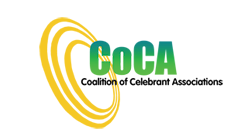October 2016
Changes to the Marriage Act 1961
Purpose
To advise the Department on areas of the Marriage Act that CoCA considers warrant change and to have a record of these issues to inform any future changes to the Marriage Act.
Background
Since the Marriage Act was created in 1961, there have been many changes in society and to the Marriage Act. The Marriage Act is inconsistent now in its requirements for the authorisation of marriage celebrants and its regulation of the different Subdivisions of marriage celebrants, even though all marriage celebrants perform the same functions on behalf of the government whether the ceremony is religious or civil, long or short.1
CoCA considers that the Marriage Act requires a number of changes to ensure the principles underpinning the Act and the major changes implemented in 2003 are consistent across all groups of marriage celebrants. Some differences now relate to age of authorisation, geographic distribution of religious and civil celebrants per the marrying public, pre-authorisation training requirements, continuing professional development, fit and proper persons criteria, conflict of interest and conditions determining continued authorisation.
CoCAs concerns are two-fold. Firstly the increasing differences between religious and civil celebrants and the impact of this on marrying couples under the Act. Secondly, the need for a consistent approach to marriage in Australia to assist in addressing child and forced marriage concerns by public education and other means.
CoCA’s recommendations to government as at October 2016 are:
1. The Marriage Act is reviewed and revised to ensure the same basic requirements for legal marriage are present in every wedding ceremony whether the ceremony is a religious or a civil one.
2. Every marriage ceremony to include consent by the parties to the marriage stated in front of an authorised celebrant, whether the celebrant is religious or civil.
3. The Marriage Vows for all marrying couples to be in plain English and modernised from the 1836 version upon which they were based to ensure the parties to the marriage clearly state "― I, A (or B.), take you, B (or A ), to be my wife (or husband or spouse) or words to that effect.
4. The Marriage Act ensures that all marriage celebrants, whether civil or religious, are treated equally with respect to the regulation of their duties in performing the valid marriage component of the wedding ceremony, whether the ceremony uses the rites of a specific religious group or a civil ceremony of the couples choice
5. Every marriage celebrant to make clear to the parties to the marriage, witnesses and all the guests that a marriage according to Marriage law is being conducted and that they are the celebrant authorised by law to witness and register the marriage.
6. Every marriage ceremony to include a definition of marriage according to law.
7. If the definition of marriage is changed to include same sex couples, that the new definition be, "marriage according to Australian law, means the union of two adults to the exclusion of all others, voluntarily entered into for life." Using the word “adults” rather than people would provide emphasis that marriage in Australia does not condone child marriage.
8. Subdivision C Authorised Marriage Celebrants be separated into two categories -
Independent Civil Marriage Celebrants and Independent Religious Marriage Celebrants.
9. The State and Territory Registry Offices to ensure that registration of all births, deaths and marriages continue to be their primary focus. There are real concerns that State and Territory Registry staff use tax payer resources to conduct marriages outside the registry office rather than focus on their primary role of registration.
(Note: In the interim, the support for Commonwealth celebrants have been significantly reduced by State registries. Online registration is expanding into a third State, where it seems that Registrar’s expectation is that Commonwealth celebrants provide free data entry and even storage of document – both formerly responsibilities of the State government. Recognising that this group comes under State legislation, a comment from the Attorney-General’s Department would have weight.)
10. That the free data-entry services provided by marriage celebrants of Recognised Religions (Subdivision A) and Independent marriage celebrants (Subdivision C) using on line registration systems are adequately and effectively supported in return by the Registries.
To support the above:
11. All marriage celebrants, whether Subdivision A, B or C be required to complete some basic training in marriage law (e.g. VET unit CHCCEL005 Establish and maintain marriage celebrancy practice or equivalent.)
12. All marriage celebrants pay the same fee for their regulation as a marriage celebrant, and the funds raised are distributed between the Commonwealth and the States accordingly.
13. All marriage celebrants be required to do any compulsory professional development activity as determined by the MLCS.
The recommendations above have implications for various sections of the Marriage Act - in particular Sections 31, 33, 45, 46 and 113.
Current Issue: Authorisation of Commonwealth Celebrants for both civil and religious ceremonies:
About 40 celebrants are currently authorised to offer both religious and civil ceremonies. This appears to be an anomaly since Section 45 indicates that religious celebrants are to use the approved ceremony of their organisation/congregation and independent civil celebrants are heavily focused on the delivery of high quality personalised ceremonies appropriate to the needs of the couple.
Previous discussions with the Marriage Law and Celebrant Section indicated that the Department would re-establish a clear boundary between independent civil celebrants and religious celebrants.
Recommendation:
CoCA recommends that the Department provide information on the current system of authorizing some celebrants for both religious and civil ceremonies and re-establish a policy of complete separation between the two categories.
Rationale:
The basis for this separation is that civil celebrants should exercise their civil duties without reference to their personal belief system or religion.
Public confidence undermined that the marriage celebrant can deliver a civil ceremony when they have an obvious allegiance to a religious organisation
The training needs of non-aligned religious celebrants are different to those needed by independent civil celebrants.
Questions for the Department:
Could you please advise what processes the Department uses to:
1. determine the legitimacy and size of the religious organisation that an independent religious celebrant is authorised to serve, and
2. determine the content of the religious ceremony is approved by this religious organisation for the celebrant to use?


